1.d4 d5 2.c4 Bf5 - Keres Defence - download book

Why the Keres Defence? Not only in order to pay homage to the Estonian Grand Master but also because Keres was the first to adopt the sequence of moves analyzed in this volume, thus proving to have analyzed their strategic and tactical consequences with great attention. Keres utilized this defence on many important occasions, such as when he played against Botvinnik in the World Championship Tournament in 1948 with a game in which he could have acheived a most satisfactory result (line 1-chapter 4). For which motives has this opening, at first sight "heretical", been studied? In the Queen's Gambit Black is often engaged in a difficult and patient defensive strategy which in many cases can only guarantee a much suffered draw, as is the case for all of the substantially symmetrical positions.
The defence examined in this work would seem to contradict some of the conceptual foundations which have always upheld the positions which spring from the sequence 1 d4 d5 2 c4. Primarily the necessity of sustaining the "d5" pawn with the thrust in "e6" or "c6", secondly (he accelerated development of the Queen's Bishop with the second move. This most certainly represents a provocative move given that Black utilizes it in order to try to radically resolve one of the "historical" problems of the Queen's Gambit: the development of the white-square Bishop. This difficulty is not so much linked to the impossibility of getting the Bishop into an opportune square as to the the fact that its precocious exit weakens the Queen's side and, indirectly, the centre. Indeed the move 2...Bf5 deprives Black of useful momentum which would have served to adequately sustain the pawn in "d5", against which White has already begun his attack with the thrust in "c4". This last move, moreover, not only contests Black's solitary central stronghold but also prepares the opening up of the "c" file and of the "d1-a4" diagonal to the Queen, thus laying the foundations for a resilient initiative against the Queen's side which Black seems to have left defenceless with the premature mobilization of his Bishop. In the classic Urthodox Defence, for example, the development of the Queen's Bishop is postponed in order to allow Black to resist White's central offensive. Notwithstanding many evident risks the Keres Defence is perfectly playable: active under attack, solid if White decides a circumspect confrontation. One of the motives which has determined its experimentation, in contrast with the dominant strategic priciples, is without doubt that of the necessity of leaving the beaten track in order to surprise the adversary in little known positions. As shall be seen from the study of the variations to be examined it is not unrare that White falls into dangerous lines where the maximum preparation can make the difference even with top players.
The debate concerning the development of the Queen's Bishop began at the end of the last century with the imposition of the opening up of the Queen. Opening theory was still in its infancy and play experience counselled a more cautious mobilization of the Queen's side in favour of greater attention to a defence of the centre. Let us now look at the following game, even if the sequence adopted by Black has few similarities with the order of moves in the Keres Defence. In any case it is a useful example of great historic value in the understanding of how the preceding considerations developed in the course of time. Black's attempt to accelerate the mobilization of the Queen's side is effectively countered by Schlechter, but the errors committed by Perlis are, we feel, most instructive.
Author: Giovanni Falchetta
Title: "Keres Defence"
Released: 1992
Format: rar/pdf
Quality: good
Number of pages: 65
Size: 5 Mb
Comment 0